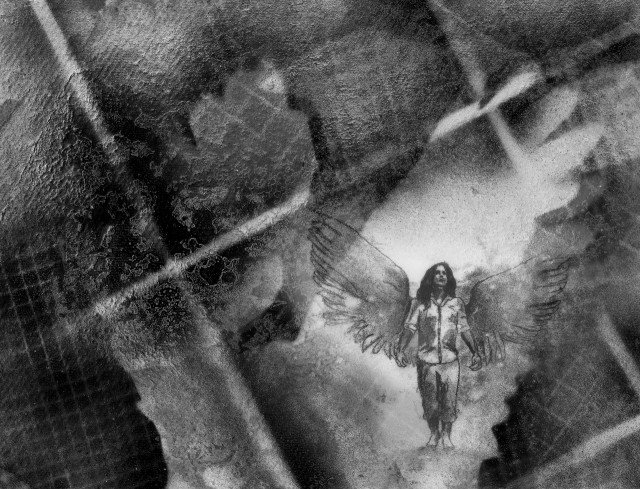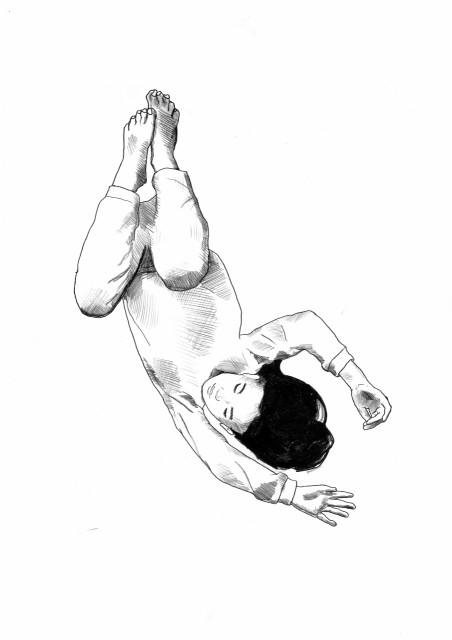Tom de Freston: Small Worlds

“Universes that blur boundaries of generation and audience.” Curator and art historian Tally de Orellana invites us into the dreamlike worlds of visual artist Tom de Freston…
Literature grants us access to imaginary spaces removed from reality, spaces where wonder and fear cohabit, allowing us readers to both escape and face the world we live in. In 2021, Oxford-based visual artist Tom de Freston gave shape to the magic of Kiran Milwood Hargrave’s tale Julia and the Shark. A year later the duo collaborated a second time in Leila and the Blue Fox. In August 2023, to celebrate the 25th anniversary of David Almond’s novel Skellig, he provided the drawings for its very first illustrated edition.
While drawing has been a fundamental element in de Freston’s practice, it has rarely been the focus of public attention or read as an illustrative narrative. The works on view at London’s No 20 Arts in de Freston’s latest exhibition, Small Worlds, show for the first time a selection of the artist’s drawings. Small Worlds features plates from Julia and the Shark, Leila and the Blue Fox, Skellig, as well as a selection of works from his ongoing collaboration with Syrian Professor of Dramatic Literature Ali Souleman, formerly shown in the exhibition From Darkness, also at No 20 Arts in summer 2022, and which strongly informed de Freston’s latest drawings.
De Freston’s paintings have often established conversations with literary works. He has illustrated Orpheus, embodied Shakespeare’s Poor Tom, given shape to Faustus’ misery. Working in the fantastical realm of children’s literature, however, the artist turned his attention to creating an ever more poignant sense of wonder and magic. In his illustrations, we follow the little paws of Fox across the Arctic with Leila; the warmth of love and harrowing confusion of Julia towards her mom; Michael’s growing loneliness, fear, and kindness towards Skellig.
The term ‘illustration’ falls short in defining these works. Each image presents a powerful scene in which depth and melancholy detach them from the pages, so much so that, in addition to mirroring the text, they also stand as individual scenes opening up to larger and more open-ended interpretations. This is because of the sheer sense of depth in de Freston’s drawings: layers of paint juxtaposed with ink play with the blank spaces of the pages while the tenderness of the imagery clashes starkly with some of the backgrounds. The artist brought images from paintings, performances, and even collages into these scenes, ultimately populating the two-dimensional medium with uncommon layers of complexity.
This textured approach defies one dimensional understandings of drawing to convey a sense of gravity. One of the illustrations for Julia and the Shark sees Julia falling into the void of the sea, her voice progressively fading. Is she being swallowed by the depths of the blue sea? Or into darkness? While illustrating a crucial passage of the book, the scene also powerfully snags the attention of the reader, who falls with her, dreams with her, fears both with and for her.

Every illustration in Julia and the Shark was made in black and yellow, the textured backgrounds contrasting with the lines defining the young heroine. These black hues are in fact remnants of a dramatic story: in 2020 a fire ravaged de Freston’s studio. Engaging creatively with the destruction to turn towards a new chapter, he used the ashes from the fire to make these drawings, giving a new life to past work, and embedding the narrative with a powerful sense of hope. In Leila and the Blue Fox blue hues spill riotously across the book’s pages, as the reader crosses ice, water, and snow to follow the journey of the arctic fox across Norway and Greenland. Each book contains a small world and de Freston’s imagery gives them a characterizing aesthetic making them unapologetically unique.
There is more to these small worlds than the illustration of children’s narrative. De Freston creates universes that blur the boundaries of generation and intended audience. His depictions are attractive to young readers, of course, but like all great art, they contain implications and inferences belying the books’ suggested age-range. There is warmth and magic in these drawings, but there is also lonesomeness and fear. The rendering of Skellig at night, as ‘Moonlight came through the arched window (…) sat before its frame, bowed forward’ operates as an illustration of a mystical psychological landscape set by Almond, but also evokes overwhelming feelings of dread and despair to which older audiences will no doubt respond, and even project onto. The simplicity of these illustrations, ultimately, allows the most complex feelings to take a visible and coherent shape allowing us, if even for a split second, to see our world, our reality, through a new, fantastic lens.
Tally de Orellana is a curator, art historian and writer based in London and Philadelphia. Born in Spain and raised in Italy, France, and the UK, she has worked with contemporary artists across Europe and the US
Small Worlds is on display at No 20 Arts, London, until 9 September
Images © Tom de Freston





